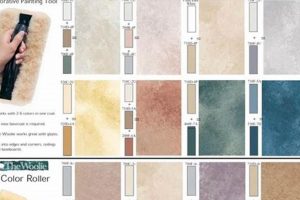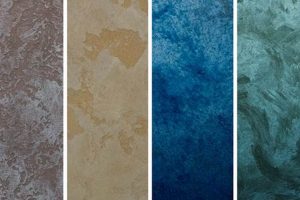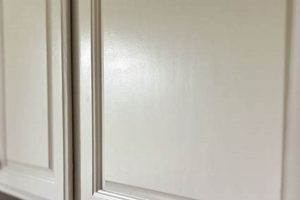Achieving a flawless, level coating when painting is often the desired outcome for both professionals and do-it-yourself enthusiasts. The tool selected to apply the paint significantly impacts the final result. The phrase refers to selecting the appropriate applicator designed to minimize texture and imperfections in the painted surface, resulting in an even, aesthetically pleasing appearance. For instance, using a high-density foam roller on a smooth wall will typically produce a less textured surface compared to using a thick-nap roller.
The attainment of this outcome is paramount for several reasons. Primarily, a uniform coating enhances the visual appeal of the painted area, conveying a sense of quality and meticulousness. Furthermore, a smooth surface is easier to clean and maintain over time. Historically, achieving a level coating required considerable skill and experience with traditional brushes. The development of specialized applicators has democratized the process, enabling a wider range of individuals to achieve professional-looking results.
Subsequent discussion will delve into the various types of applicators available, factors influencing their performance, and techniques for optimizing the application process to minimize surface imperfections. This will include examination of nap materials, roller frame design, paint types, and surface preparation methodologies.
Tips for Achieving a Flawless Painted Surface
Optimizing painting technique is crucial for obtaining a level and aesthetically pleasing result. The following guidelines offer insights into achieving a coating free from excessive texture and imperfections.
Tip 1: Select the Appropriate Nap Material: Fine-nap rollers, typically microfiber or foam, are conducive to smooth applications. Avoid thick-nap rollers on smooth surfaces as they tend to create an “orange peel” texture.
Tip 2: Employ a High-Quality Roller Frame: A durable frame with a smooth rolling action is essential. Ensure the roller sleeve fits snugly on the frame to prevent slippage and uneven paint distribution.
Tip 3: Prime the Surface: Applying a primer creates a uniform base for the paint, mitigating inconsistencies in surface texture and porosity. This promotes even paint absorption and a smoother finish.
Tip 4: Load the Roller Evenly: Submerge the roller sleeve partially in the paint tray and roll it back and forth on the ramp to distribute the paint uniformly. Avoid overloading the roller, as this can lead to drips and uneven application.
Tip 5: Utilize a Consistent Rolling Technique: Apply the paint in a “W” or “N” pattern, overlapping each stroke slightly to ensure complete coverage. Maintain consistent pressure to avoid variations in paint thickness.
Tip 6: Feather the Edges: Lightly lift the roller at the end of each stroke to blend the paint seamlessly and prevent hard lines or ridges.
Tip 7: Consider Paint Sheen: Higher sheen paints (e.g., gloss or semi-gloss) tend to highlight imperfections. Lower sheen paints (e.g., matte or eggshell) are more forgiving and can help conceal minor surface flaws.
Implementing these techniques will contribute significantly to a more refined outcome, characterized by minimal texture and enhanced visual appeal.
The subsequent section will address common problems encountered during painting and strategies for their resolution.
1. Nap Material
The nap material of a paint roller directly influences the texture and uniformity of the painted surface, thereby serving as a critical determinant in achieving a level coating. Nap refers to the fibers extending from the roller’s core, and its composition, length, and density all contribute to the final appearance of the painted substrate. For instance, rollers with short, dense microfiber naps are designed to minimize stippling and produce a surface with reduced texture. Conversely, rollers with longer, thicker naps, such as those made from sheepskin or synthetic blends, are better suited for textured surfaces or applications where a slight degree of stippling is acceptable or desired. Selecting an inappropriate nap material can result in visible imperfections, such as excessive orange peel or uneven paint distribution, detracting from the overall aesthetic quality.
The selection process necessitates careful consideration of both the paint type and the surface being painted. Smooth walls or ceilings typically benefit from fine-nap rollers, while rough or porous surfaces may require a longer nap to ensure adequate paint coverage. For example, applying a high-gloss paint with a thick-nap roller on a smooth wall will invariably result in an undesirable level of texture. Conversely, attempting to paint a stucco wall with a fine-nap roller will likely lead to insufficient paint transfer and incomplete coverage. Understanding these interactions allows for the informed selection of the appropriate nap material, contributing significantly to the final result.
In summary, the appropriate choice of nap material is not merely a superficial consideration but a fundamental aspect of achieving a uniform coating. The interplay between nap characteristics, paint properties, and surface texture dictates the success or failure of the painting endeavor. Ignoring this critical factor can lead to suboptimal results and the need for corrective measures, ultimately increasing both time and expense. Therefore, a thorough understanding of nap materials is essential for any painting project where a level coating is the desired outcome.
2. Roller Frame
The roller frame, often an overlooked component in the painting process, exerts a significant influence on the attainment of a level coating. Its primary function is to secure the roller sleeve and facilitate the application of paint to the surface. However, the frame’s design, materials, and overall quality directly impact the uniformity of paint distribution and the applicator’s maneuverability. A substandard frame, characterized by poor construction or an ill-fitting sleeve, can cause uneven paint application, streaking, and an increase in surface texture. For example, a warped or bent frame will not maintain consistent contact with the wall, resulting in variations in paint thickness and visible imperfections. The correlation between frame integrity and coating quality is direct and substantial.
The practical implications of using a high-quality roller frame extend beyond simply achieving an aesthetically pleasing result. A robust frame enhances efficiency by minimizing slippage and reducing the effort required to apply paint. This is particularly relevant in large-scale projects or when working on ceilings, where consistent pressure and controlled movements are essential. Furthermore, a well-designed frame often incorporates features that simplify tasks such as roller sleeve replacement and cleaning. Professionals frequently invest in durable, ergonomic frames to improve productivity and minimize fatigue. The longevity of a quality frame represents a cost-effective solution compared to frequent replacement of inferior models, solidifying its importance in achieving efficiency during painting projects.
In conclusion, the roller frame is an integral element in achieving a flawlessly coated surface. Its impact on paint distribution, maneuverability, and overall efficiency is undeniable. While the selection of the appropriate nap material and paint type are essential, the frame’s structural integrity and design characteristics should not be underestimated. Investing in a quality roller frame contributes directly to a more uniform result, reduced application time, and a higher standard of finish, aligning with the goals of delivering a level coating.
3. Paint Viscosity
Paint viscosity, defined as a fluid’s resistance to flow, exerts a considerable influence on the feasibility of achieving a flawlessly coated surface. This property directly affects how paint is picked up, transferred, and laid down by the applicator. If the viscosity is too high, the paint will resist flowing smoothly from the roller onto the surface, leading to a textured, uneven appearance. Conversely, if the viscosity is too low, the paint may run or sag, resulting in insufficient coverage and potential drips. A paint with optimal viscosity allows for even distribution and leveling, minimizing roller marks and surface imperfections. For instance, using a paint formulated for spray application with a roller often results in poor coverage and excessive dripping due to its inherently low viscosity.
Adjusting paint viscosity is often necessary to optimize application. This can be achieved through thinning agents, which reduce the fluid’s resistance to flow, or by allowing the paint to stand, permitting some solvent evaporation and a corresponding increase in viscosity. The correct approach hinges on the specific paint type and environmental conditions. For example, in hot weather, paint viscosity tends to decrease, requiring adjustments to prevent running. Manufacturers typically provide guidelines regarding thinning ratios and appropriate application techniques. Adhering to these recommendations helps ensure proper paint flow and minimizes the risk of surface defects. Furthermore, some paints are designed with self-leveling properties, which help to mitigate minor variations in viscosity and promote a smoother result.
In summary, paint viscosity is a critical determinant in the pursuit of a level coating. Its influence on paint flow, transfer, and leveling makes it a factor that cannot be overlooked. Understanding and managing viscosity through appropriate thinning or selection of paints with self-leveling characteristics are essential steps in achieving a professional-quality finish. Neglecting this aspect can lead to an array of surface imperfections and necessitate corrective measures, underscoring the importance of viscosity management in painting projects.
4. Surface Preparation
Achieving a flawlessly coated surface is predicated on meticulous surface preparation. The relationship between surface preparation and the quality of the final coating is direct and causational. Pre-existing imperfections, contaminants, or inconsistencies in the substrate will invariably manifest in the applied paint film, irrespective of the quality of the paint or the skill of the applicator. For instance, painting over a surface with residual dust or grease will impede paint adhesion, leading to peeling or blistering. Similarly, attempting to paint a porous surface without prior sealing will result in uneven paint absorption and a textured appearance. Surface preparation is, therefore, not merely an ancillary step, but an indispensable component in achieving a uniform result.
Practical surface preparation encompasses several key actions. Initially, thorough cleaning is essential to remove dirt, grease, and loose particles. This may involve washing the surface with detergent, scraping away loose paint, or sanding to create a smooth profile. Subsequent filling of cracks and holes with appropriate patching compounds is necessary to eliminate surface irregularities. Sanding the filled areas to match the surrounding surface ensures a seamless transition. Priming is the final, crucial step, establishing a uniform base for paint adhesion and mitigating variations in surface porosity or color. Selecting the correct primer is vital; for example, using an oil-based primer over latex paint can lead to adhesion failures. Proper execution of each step guarantees an optimal foundation for paint application.
In summation, effective surface preparation is a prerequisite for achieving a high-quality paint coating. The absence of proper preparation will invariably compromise the final result, rendering other efforts futile. While the selection of appropriate paint and application techniques is important, these factors are subordinate to the establishment of a sound substrate. Recognizing surface preparation as a critical determinant allows for a systematic approach to painting, optimizing both the aesthetic quality and the longevity of the coated surface. The challenge lies in consistently executing each preparatory step with meticulous attention to detail, thereby creating the ideal canvas for the final application.
5. Application Technique
The successful achievement of a flawlessly coated surface is inextricably linked to the application technique employed. The manner in which paint is applied directly governs the uniformity, texture, and overall aesthetic quality of the finished product. Inadequate technique can negate the benefits of selecting high-quality paint, rollers, and performing meticulous surface preparation. For example, applying excessive pressure during roller application can result in visible roller marks and uneven paint distribution, diminishing the desired outcome. Conversely, insufficient paint loading on the roller will lead to inconsistent coverage and a streaked appearance. The connection is therefore foundational: application technique serves as the catalyst in translating preparation and materials into a superior finish.
Critical aspects of application technique include consistent roller speed, controlled pressure, and strategic overlap of each pass. Maintaining a uniform roller speed promotes even paint transfer, while regulating pressure avoids excessive or inadequate paint deposition. Overlapping each stroke by approximately 50% ensures complete coverage and minimizes the appearance of lines or edges. Furthermore, the direction of application can impact the final result; for instance, painting with the light source helps identify and correct imperfections in real time. Skilled applicators understand these nuances and adapt their technique according to the specific characteristics of the paint, roller, and surface. In practice, a professional painter might employ a “W” or “N” pattern to distribute paint evenly, followed by a light, feathering pass to eliminate any remaining imperfections.
Understanding the profound influence of application technique is essential for consistently achieving a flawlessly coated surface. While material selection and preparation lay the groundwork, the application method is the defining step. Challenges arise from variations in paint viscosity, surface texture, and environmental conditions; however, a mastery of application technique provides the adaptability needed to overcome these obstacles. Ultimately, successful application technique transforms theoretical preparation into tangible results, establishing it as a cornerstone of the pursuit of a superlative painted surface.
Frequently Asked Questions
This section addresses common inquiries regarding the selection and utilization of painting rollers to produce surfaces with minimal texture and a uniform appearance.
Question 1: What nap length is most suitable for achieving a flawlessly coated surface?
Shorter nap lengths, typically ranging from 1/4 inch to 3/8 inch, are generally recommended for smooth surfaces. These nap lengths minimize stippling and the creation of an “orange peel” texture. Longer nap lengths are more appropriate for textured surfaces requiring greater paint coverage.
Question 2: Are foam rollers superior to microfiber rollers for smooth applications?
Both foam and microfiber rollers are suitable for achieving smooth finishes. Foam rollers are particularly effective with high-gloss paints, while microfiber rollers offer excellent paint absorption and release, making them versatile for a wider range of paint types.
Question 3: Does the density of the roller material impact the final outcome?
Yes, denser roller materials tend to produce smoother finishes. Higher density rollers minimize air pockets and ensure more uniform paint distribution across the surface.
Question 4: Can a specific paint type influence the choice of roller?
Certain paint types, such as epoxy or urethane coatings, may require specialized rollers resistant to chemical degradation. Additionally, thicker paints may necessitate rollers with higher paint-holding capacity.
Question 5: Is roller frame quality a significant factor in achieving a level coating?
A high-quality roller frame is essential. A durable frame with a smooth rolling action prevents slippage, ensures even paint distribution, and minimizes fatigue during extended use.
Question 6: How does roller cleaning influence the longevity and performance of the applicator?
Thorough cleaning of the roller after each use prevents paint buildup and maintains the nap’s integrity. Proper cleaning extends the roller’s lifespan and ensures consistent performance over multiple applications.
Effective roller selection and maintenance are paramount in achieving a flawlessly coated surface. Careful consideration of nap length, material density, and frame quality is crucial for optimizing the application process.
The succeeding section will focus on specific techniques for minimizing roller marks and achieving a professional-quality paint finish.
Conclusion
The preceding exploration has underscored the multi-faceted nature of achieving a flawless coating. The concept, encapsulated by best paint roller smooth finish, extends beyond a mere product selection. It encompasses a strategic integration of appropriate tools, meticulous surface preparation, optimized paint characteristics, and refined application techniques. Each element contributes critically to the final aesthetic and functional outcome.
The pursuit of surface perfection demands a commitment to knowledge and precision. Continuous refinement of methodology, coupled with a thorough understanding of materials, will invariably yield superior results. Therefore, diligent application of the principles outlined herein will serve as a cornerstone for achieving consistent and commendable outcomes in any painting endeavor.







